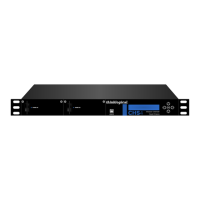TLX Matrix Switch ASCII API V5 5 Rev. I, January 2019
Overview
This document describes the command set used to control Thinklogical's TLX series of Matrix
Switches. The commands are all ASCII based and are terminated with either a linefeed character or
a carriage-return/linefeed pair. Port numbers are all 4 digits in length and filled with leading zeros
(Example: port 12 is encoded as 0012).
The TLX Matrix Switch API commands are based on the command set used by our VX Matrix Switch
product line and detailed in the document: Matrix_Switch_ASCII_API.
API Version 4 Commands That Were Modified in Version 5
The following commands were modified in Version 5 of the API.
• XDCSTYPE Renamed XTYPE
• XMAXCARDS Returns the maximum number of I/O cards, not half the maximum.
Uni-directional vs. Bi-directional
As used in this document, uni-directional is a connection that is made in only one direction,
from an input to an output. Note that an input may be directed to multiple outputs at one time. The
direction refers to data flow between a transmitter and a receiver or between a receiver and a
transmitter (a backchannel).
Some of our VX Matrix Switches have the capability to create two connections at one time, creating a
bi-directional connection. Bi-directional connections are still possible with TLX Series Matrix Switches
(and in most cases necessary for the correct operation of the switch) but must be created by issuing
two uni-directional commands. The TLX Series Matrix Switches are considered unidirectional devices.
Note: API commands shown in this manual are depicted in UPPER-CASE. This is for
clarity purposes only. The latest API allows commands to be in upper or lower case. Bit 2
(0x04) of the XOPTIONS status result is set to a 1 if the Switch requires upper-case
commands. This bit is there for the instances where a control system must interface with
different models and vintages of our Switches.
This manual reflects version V5.07.02 of the ASCII API.
Conventions
Port Numbers
▪ All port numbers are four places long, begin with 1 and have leading zeros. For example, port 15 is
encoded as 0015.
▪ A port number of 4 zeros is used in response to a status command to signify that no port is in use.
A “zero” port number is not valid in a command string.
▪ A port number of four 9s (9999) in used to signify ALL ports. It is not valid in a response.
For example, to encode all output ports, use: O9999
▪ In the following sections, xxxx is used as a generic input port place holder; yyyy is used as the
output port place holder.
Note: Do not use xxxx or yyyy in a command! Replace each with the appropriate input or
output port number.

